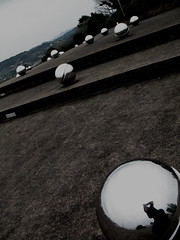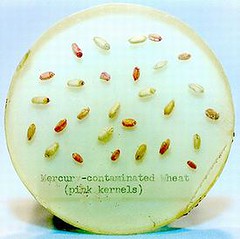 來自147國的代表於日內瓦聯合國論壇中首次通過全球協定,於2020年起將禁止製造、進出口含汞電池及其他含汞產品。
來自147國的代表於日內瓦聯合國論壇中首次通過全球協定,於2020年起將禁止製造、進出口含汞電池及其他含汞產品。
汞及其多數化合物對人類、動物及生態系都有極高的毒性。高劑量時對人類是致命的,即便是相對較低的劑量也可能會嚴重影響人類神經系統,並對心血管、免疫系統和生殖系統產生有害影響。
在細菌作用下,汞可轉變成其最毒的型態──甲基汞。甲基汞可輕易穿透胎盤及腦血管障壁,因而暴露在甲基汞的生育期婦女及孩童受到高度關切。
該協定明列禁止的產品包括含汞的肥皂及化妝品、開關、繼電器、某些類型的節能燈、含汞的冷陰極螢光燈及等離子燈。特定類型的非電子醫療設備,如汞溫度計和血壓計等,2020年前會逐步淘汰。
植入性醫療裝置的鈕釦電池、使用汞作為防腐劑的疫苗及用於宗教或傳統儀式中的產品,則訂為例外項目。
召開此次會談的聯合國環境規劃署執行長史坦納(Achim Steiner)表示,經過「複雜又常常是通宵達旦的談判」,全球具有法律效益的《水俁公約》(Minamata Convention on Mercury)在1月19日達成共識。
這份公約的名稱是為了紀念日本水俁灣事件,從1932年到1968年,工廠排放27噸致命的有機汞廢水進入水俁灣。根據日本國立水俁症研究所的資料,超過2000人因食用該港灣內的魚類而死亡,另有超過1萬人得到排汞禍首Chisso石化公司的補償金。
 史坦納指出,「全球的每個人都將因這次的日內瓦會議決議而受益,特別是那些在小型金礦廠工作的工人及家庭、北極圈內的人們、這一代及未來世代的母親與嬰兒。」
史坦納指出,「全球的每個人都將因這次的日內瓦會議決議而受益,特別是那些在小型金礦廠工作的工人及家庭、北極圈內的人們、這一代及未來世代的母親與嬰兒。」
歐盟環境執委波托奇尼克(Janez Potocnik)也同意,「考量汞在空氣中可傳播長遠的距離,這份新公約將使全球所有族群受益,包括歐盟的公民。在食物鏈的汞循環中,孕婦、嬰兒和孩童承受特別高的風險,而這份公約將顯著減少他們與這種有毒物質的接觸。」
日本環境省國立水俁病綜合研究所國際與綜合研究部長坂本峰至(Yoshiaki Yasuda)解釋,汞會在土地、水域、大氣以各種化學型態循環。
《水俁公約》完整涵蓋汞的生命週期,從初級開採到廢物處置的各個階段,包括貿易條款、人力及小規模金礦開採規則、含汞產品及排放到空氣的汞。公約要求針對高危險族群提供醫療服務,並對診斷及治療衛生保健專業人員提供更好的訓練。
《水俁公約》涵括汞開採、汞的進出口及汞廢棄物的安全儲存。
從 醫療器具(溫度計等)、省電燈泡到水泥及燃煤電力行業的所有產品、工藝及工業,都將受該公約約束汞的使用。
醫療器具(溫度計等)、省電燈泡到水泥及燃煤電力行業的所有產品、工藝及工業,都將受該公約約束汞的使用。
金礦開採過程使用汞會導致對採礦者的健康危害,公約也包含這個部分。
協議中並有關於未來發展的條款,當未來相關議題產生時,可採取進一步行動。
Potocnik委員表示:「這份公約對於全面淘汰汞提供強勁的推力,且我們自豪於許多歐盟的理念和想法都被加入這個文本中。」水俁公約的採用在他的議程中排在很前面。
波托奇尼克指出,「歐盟已為了全球性的汞公約奮鬥了7年,而我們終於走到這一步。我們達成了一個有力、均衡及動態的環境協議。」史坦納也認為,各國為「這種近100多年來惡名昭彰的污染物奠定了全球應變基礎。我期待水俁公約可迅速獲得各國批准,儘快生效。」
不過,這兩位官員也知道要減少環境中的汞含量,還需要一段時間。「雖然歐盟已有汞循環各階段的應對方案,但不幸的是世界上其他地區還有很多缺乏類似的方案。」波托奇尼克補充,「但期待世界上其他一百多個經濟與生活條件明顯顯然與歐洲人不一樣的國家,遵行歐盟的標準顯然不太實際。」
A worldwide ban on the manufacture, export and import of batteries and other products that contain mercury will be in place by 2020 under the provisions of the world's first treaty agreed by 147 governments at a United Nations forum in Geneva.
Mercury and most of its compounds are highly toxic to humans, animals and ecosystems. High doses can be fatal to humans, but even relatively low doses can seriously affect the nervous system and have been linked with possible harmful effects on the cardiovascular, immune and reproductive systems.
In the presence of bacteria, mercury can change into methylmercury, its most toxic form. Methylmercury easily passes through both the placenta and the blood-brain barrier, so exposure of women of child-bearing age and of children, is of greatest concern.
On the treaty's list of products to be banned are soaps and cosmetics containing mercury, switches and relays, certain types of compact fluorescent lamps (CFLs), mercury in cold cathode fluorescent lamps and external electrode fluorescent lamps.
Certain kinds of non-electronic medical devices such as thermometers and blood pressure devices are also marked for phase-out by 2020.
Exceptions were made for ‘button cell' batteries used in implantable medical devices, vaccines where mercury is used as a preservative, as have products used in religious or traditional activities.
Global and legally-binding, the Minamata Convention on Mercury was reached Jan. 19 after "complex and often all-night sessions," said Achim Steiner, executive director of the UN Environmental Programme, UNEP, which convened the talks.
The treaty takes its name from Japan's Minamata Bay, contaminated with some 27 tons of deadly organic mercury from industrial waste from 1932 to 1968.
More than 2,000 people who ate fish from the bay have died and over 10,000 others have received financial compensation from Chisso, the petrochemical and plastics factory that discharged the mercury, according to Japan's National Institute for Minamata Disease.
"Everyone in the world stands to benefit from the decisions taken this week in Geneva, in particular the workers and families of small-scale gold miners, the peoples of the Arctic and this generation of mothers and babies and the generations to come," Steiner said.
Janez Potocnik, European Commissioner for Environment, agrees. "This new treaty will bring benefits to all populations around the world, including the citizens of the EU, given the long distances that mercury can travel in the air."
"Pregnant women, infants and children are at particular risk from mercury in the food-chain," he said, "and this treaty will bring about significant decreases to their exposure to this toxic substance."
Mercury circulates through land, water, and the atmosphere, and its chemical form changes in each domain, explains Yoshiaki Yasuda, Department of International Affairs and Environmental Sciences, National Institute for Minamata Disease, Ministry of the Environment, Japan.
The new treaty covers all phases of the mercury cycle, from primary mining to waste disposal, including trade provisions, rules for artisanal and small scale gold mining, products containing mercury and mercury emissions to air.
It calls for pinpointing populations at risk, boosting medical care and better training of health care professionals in identifying and treating the effects.
The Minamata Convention on Mercury covers the direct mining of mercury, as well as export and import of the metal, and safe storage of waste mercury.
It places controls on mercury and mercury reductions in products, processes and industries ranging from medical equipment such as thermometers and energy-saving light bulbs, to the cement and coal-fired power sectors.
Using mercury to extract gold poses health risks to artisanal miners and the treaty covers this use.
And when issues arise in the future, there is a provision in the agreement for future development so that further action can be taken.
"The new treaty is a forceful driver towards a comprehensive mercury phase-out, and we are proud to see that many EU concepts and ideas have made its way into the text," Commissioner Potocnik.
Early adoption of the Minamata Convention is high on his agenda.
"The EU has fought for a global mercury treaty for almost seven years – and now we are there," Potocnik said. "We have reached a robust, balanced and dynamic environmental agreement."
Steiner said nations "have laid the foundations for a global response to a pollutant whose notoriety has been recognized for well over a century."
"I look forward to swift ratification of the Minamata Convention so that it comes into force as soon as possible," he said.
But both men know it will take time to reduce levels of mercury in the environment.
"Whilst the EU has an overarching strategy for controlling mercury at all stages of the mercury life-cycle, such controls are unfortunately lacking in many parts of the world," said Potocnik.
"It would be unrealistic," said the commissioner, "to expect more than 100 countries around the world, with economies and living conditions significantly different to those of European citizens, to simply live up to our environmental standards here and now."
※ 全文及圖片詳見:ENS





